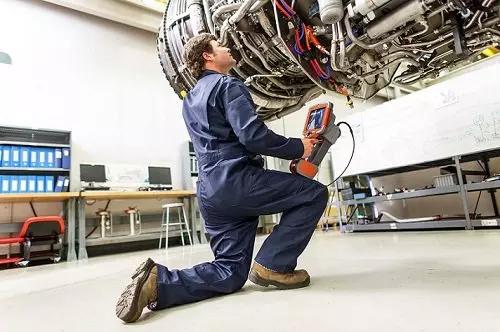GE Aerospace’s MRO Investments Enhanced by AI Tools, Digital Training, and Lean Business Strategy
GE Aerospace’s lean operating model and overall industry growth have spurred investments by standardizing processes and fostering operational efficiency and reliability.
GE Aerospace is investing over $130 million in its European maintenance, repair, and overhaul (MRO) and component repair facilities as part of the company’s $1 billion MRO spending surge that was approved in early 2024. These funds will support engine test cells, new equipment, and new technology such as AI-powered enhanced inspection techniques.
One of GE Aerospace’s spokespersons shared how the recent investments support numerous activities across its MRO facilities and credits a growing aviation market and the company’s lean operating model, FLIGHT DECK, for spurring the demand for these investments.
FLIGHT DECK is a systematic, lean, and waste-reducing approach to running the business using 10 fundamentals that allow the company to deliver value for its customers. At the heart of FLIGHT DECK is “kaizen,” a method that achieves continuous improvement using data-driven, team-oriented, and structured problem-solving to eliminate waste and generate more value with fewer resources.
The spokesperson also offered insight into how the company utilizes AI, augmented reality (AR), and virtual reality to assist MRO operations.
TURBO: What factors are accelerating the growth of the global aircraft MRO market?
GE Aerospace: Growth is driven by increasing air travel demands, aging aircraft fleets, and technological advancements that necessitate more frequent MRO services.
TURBO: How does this investment support LEAP engines at the XEOS overhaul facility?
GE Aerospace: XEOS will focus exclusively on servicing LEAP engines as overhaul and repair demand for the maturing fleet continues to grow. Lean principles enhance turnaround times, thus minimizing downtime for airlines.
TURBO: How does employee use of FLIGHT DECK improve safety, quality, delivery, and cost and help spur investments in these facilities?
GE Aerospace: FLIGHT DECK improves safety, quality, delivery, and cost, and spurs investments by standardizing processes and fostering continuous improvement. This leads to higher operational efficiency and reliability, encouraging further investments in European MRO facilities to meet growing demand.
AI-Assisted Inspection Tools
GE Aerospace and Waygate Technologies developed an AI-assisted borescope inspection model for commercial jet engines. It’s equipped with a computer-optimized object detection algorithm and temporal smoothing algorithm that increase model recall rates and decrease the false positive rate. It improves inspection workflows and increases reliability by reducing the inspector learning curve and identifying previously difficult-to-detect defects. It also features an automated data anonymization tool to protect partner data and enable integration into the training dataset.
Engineer performing borescope inspection on aviation engine.

GE Aerospace also deployed two AI-enabled inspection tools for the CFM LEAP and GE9X aviation engines. The AI selects consistent blade images and builds predictive models based on verified domain data. The AI-enabled Blade Inspection Tool delivers more accurate inspections to minimize turnaround times, maximize time-on-wing, and reduce engine service time for airline customers.
TURBO: What are the advantages of AI-enabled inspection techniques when applied to aircraft engine MRO work? How does this enhancement reduce turnaround times and expand component repair capability?
GE Aerospace: With our AI-enabled Blade Inspection Tool, the AI guides the selection of the blade’s most optimal images for engineers to analyze, assisting with the inspection itself. This has allowed us to reduce the processing time for inspections from 3 to 1.5 hours versus standard borescope inspections while improving the accuracy of inspections.
AI is also helping MRO organizations accurately forecast final work scopes and parts required for repairs months before an engine’s induction date. Using AI, we’re able to predict part requirements before an engine comes into an MRO shop, avoiding any undue delays in repairing and returning an engine to service.
AR/VR Training
GE Aerospace’s Customer Technical Education Center (CTEC) integrates AR training courses to supplement in-person training. CTEC used a GE9X engine for customer training courses, including line maintenance, borescope, and boroblend repair procedures as well as fan stator removal and installation. The virtual trainings accelerated the learning curve for these activities and since then, these platforms have been further integrated into aircraft MRO work.
TURBO: Does GE Aerospace use AR platforms to train maintenance personnel? If so, what are the advantages of using these technologies? Additionally, how does training occur with these technologies?
GE Aerospace: GE Aerospace uses AR platforms to train personnel for engine maintenance tasks. We make these experiences available through laptops, tablets, and smartphones with training occurring in both physical and virtual classroom settings.
With the adoption of AR-driven training, we’re seeing a faster skill ramp-up with maintenance personnel, optimized cycle times for maintenance activities, and an overall improved capacity to provide more training opportunities.
TURBO: What other needs does GE Aerospace plan to address with its MRO spending surge?
GE Aerospace: It addresses capacity expansion intended to reduce turnaround times for customers and expand component repair capabilities.